Calming herbal tea blends are your go-to solution for natural stress relief. You can mix soothing ingredients like chamomile, lavender, peppermint, and lemon balm to create revitalizing brews. For a simple recipe, steep dried chamomile and lavender flowers for 5 to 7 minutes for a calming experience. If you prefer an invigorating twist, try boiling fresh peppermint with lemon balm leaves. Alternatively, ginger and turmeric combined can ease digestion and inflammation. Each blend brings unique benefits to help you unwind. Stick around, and you'll uncover even more delightful recipes to enhance your relaxation routine.
Benefits of Herbal Tea
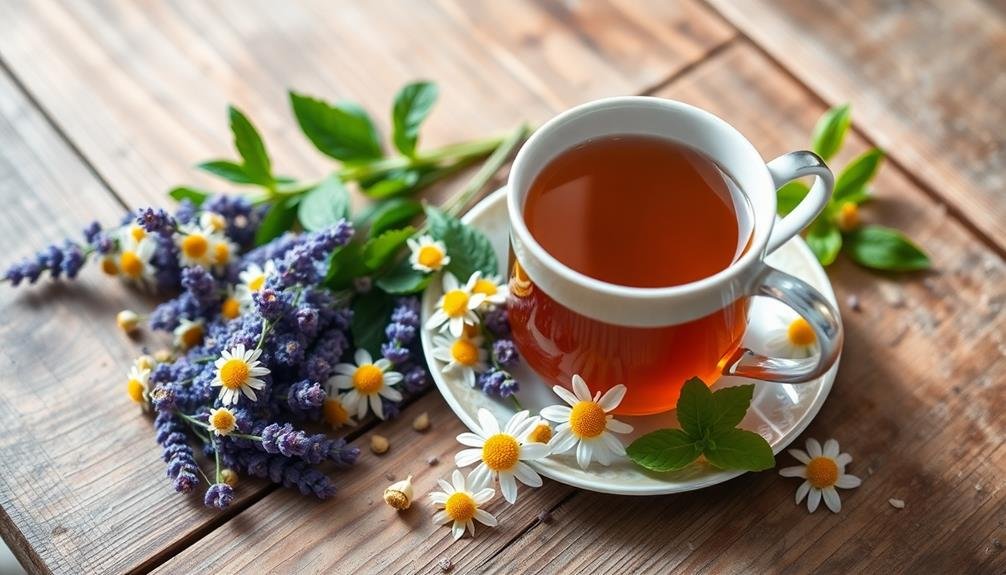
Herbal tea offers a soothing escape from the chaos of daily life, bringing a host of benefits that can enhance your overall well-being. First and foremost, it's a great way to hydrate yourself. While water is essential, infusing your hydration routine with herbal tea adds variety and flavor without added calories.
You'll also find that many herbal teas have calming properties, helping to reduce stress and anxiety. Sipping on a warm cup can create a mindful moment, allowing you to pause and breathe deeply. The act of brewing and enjoying your tea can be a ritual that promotes relaxation in your hectic schedule.
Moreover, herbal teas can aid digestion, easing discomfort and bloating after meals. They've been known to support sleep, too. Many people turn to herbal blends in the evening to signal their bodies that it's time to wind down.
Key Ingredients for Relaxation
Finding the right ingredients can elevate your tea experience and enhance relaxation. When crafting a calming herbal tea, focus on ingredients known for their soothing properties. Here are some key players that can help you unwind.
| Ingredient | Benefits |
|---|---|
| Chamomile | Promotes sleep, eases anxiety |
| Lavender | Reduces stress, enhances mood |
| Lemon Balm | Calms nerves, improves sleep quality |
| Passionflower | Alleviates anxiety, supports relaxation |
These ingredients work wonders when combined, creating a harmonious blend that can ease your mind and body. Chamomile has long been praised for its sleep-inducing qualities, making it a staple in any calming tea. Lavender not only smells delightful but also helps to reduce stress levels. Lemon balm is another fantastic option that calms your nervous system while promoting restful sleep. Finally, passionflower serves as a natural remedy for anxiety, helping you find your zen.
Experiment with these ingredients to discover the perfect balance for your relaxation needs. The right combination can make all the difference in your tea ritual, inviting serene moments into your day.
Recipe: Chamomile and Lavender

If you're looking to unwind, chamomile and lavender make a perfect duo.
Chamomile offers numerous benefits, while lavender's soothing properties enhance the calming experience.
Let's explore how to brew this delightful tea and reveal its full potential.
Benefits of Chamomile
Chamomile is a beloved herb known for its calming properties, making it a popular choice for those seeking relaxation. When you sip chamomile tea, you're not just enjoying a warm beverage; you're also tapping into a wealth of benefits. This gentle herb is renowned for its ability to reduce anxiety and promote better sleep. If you struggle with restless nights or racing thoughts, chamomile can help soothe your mind and create a sense of tranquility.
Moreover, chamomile has anti-inflammatory properties that can aid in digestion and alleviate stomach discomfort. If you often experience digestive issues, drinking chamomile tea can provide relief. It's also rich in antioxidants, which support overall health by fighting free radicals in your body.
In addition to its calming effects, chamomile can enhance your mood. Regular consumption may help lift your spirits and encourage a sense of well-being.
Soothing Lavender Properties
As evening falls and you seek a moment of peace, lavender's soothing properties can be the perfect complement to chamomile. This delightful blend not only calms your mind but also enhances your overall sense of well-being. Lavender's gentle aroma has been cherished for centuries, known for its ability to ease anxiety and promote relaxation.
When you indulge in a cup of chamomile and lavender tea, you invite a wave of tranquility that soothes your senses. Picture the calming experience as you sip:
- Delicate lavender blooms, releasing a sweet, floral fragrance
- Golden chamomile petals, radiating warmth and comfort
- Gentle steam rising from your cup, wrapping you in serenity
- A soft, cozy blanket enveloping you as you unwind
- The quiet rustle of leaves outside, harmonizing with your peaceful moment
Together, chamomile and lavender create a harmonious blend that helps quiet racing thoughts and encourages restful sleep.
As you savor this soothing tea, you'll find yourself in a tranquil oasis, ready to embrace the serenity of the night. Enjoy the calming ritual, and let your worries drift away.
Brewing Tips Explained
To brew the perfect cup of chamomile and lavender tea, start by gathering the right ingredients and tools. You'll need dried chamomile flowers, dried lavender buds, a teapot or infuser, and hot water.
Begin by measuring out about one tablespoon of chamomile and one teaspoon of lavender. Combine these in your teapot or infuser. Next, heat your water to just below boiling—around 200°F (93°C) is ideal. Pour the hot water over the herbs, allowing them to steep for 5 to 7 minutes. This will help release their calming properties, creating a soothing experience.
Here's a simple table to remind you of the key elements for brewing:
| Element | Importance |
|---|---|
| Ingredients | Freshness matters |
| Water Temperature | Enhances flavor |
| Steeping Time | Maximizes benefits |
Once steeped, strain the tea into your favorite cup. Enjoy it plain or add a touch of honey for sweetness. Take a moment to savor the aroma and warmth, letting the stresses of the day melt away. You deserve this peaceful pause.
Recipe: Peppermint and Lemon Balm
When you're looking for a revitalizing way to unwind, peppermint and lemon balm make a perfect duo.
Peppermint offers a boost to your digestion, while lemon balm helps soothe your nerves.
Let's explore how to brew this calming tea and the benefits it brings.
Health Benefits of Peppermint
Peppermint is more than just a invigorating herb; it's a powerhouse of health benefits. When you sip on a warm cup of peppermint tea, you're not just enjoying a invigorating flavor; you're also giving your body some incredible perks.
- Digestive Aid: It can help soothe an upset stomach and alleviate symptoms of indigestion.
- Natural Decongestant: The menthol in peppermint acts as a natural decongestant, helping to clear your sinuses when you're feeling stuffy.
- Mood Booster: The aroma of peppermint can uplift your mood and enhance mental clarity, making you feel more focused.
- Pain Relief: Applying peppermint oil can provide relief from headaches and muscle pain, offering a natural alternative to over-the-counter medications.
- Antioxidant Properties: Rich in antioxidants, peppermint helps combat free radicals in your body, supporting overall health.
Incorporating peppermint into your daily routine, whether through tea or essential oil, can elevate your well-being.
Lemon Balm's Calming Effects
Lemon balm, with its delicate green leaves and soothing aroma, is renowned for its calming effects. This herb has been used for centuries to alleviate stress and promote relaxation. When you brew lemon balm tea, you harness its natural properties that help soothe anxiety and improve your mood. The gentle scent alone can create a sense of peace, inviting you to unwind after a long day.
Combining lemon balm with peppermint enhances this calming experience. Peppermint adds a revitalizing twist, balancing lemon balm's soothing qualities while providing additional benefits, like easing digestive discomfort. Together, they create a harmonious blend that not only tastes delightful but also supports your overall well-being.
As you sip this tea, you may notice a subtle shift in your mindset. The anxiety that once occupied your thoughts starts to fade, replaced by a serene state of mind.
Whether you're facing a hectic schedule or just need a moment of tranquility, this herbal combination can be your go-to solution. Lemon balm's calming effects can help you find that much-needed balance in your busy life, making it an essential addition to your stress-relief repertoire.
Brewing Instructions and Tips
To brew a soothing cup of peppermint and lemon balm tea, start by gathering your ingredients. You'll need fresh or dried peppermint leaves, fresh or dried lemon balm, boiling water, a teapot or infuser, and honey or lemon for added flavor, if you like.
- Fresh peppermint leaves, vibrant green and aromatic
- Dried lemon balm, with its sweet, herbaceous scent
- Boiling water, bubbling and ready to release those soothing flavors
- A cozy teapot, inviting and perfect for steeping
- Honey or a slice of lemon, to enhance the taste
Now, combine one tablespoon of each herb in your teapot or infuser. Pour the boiling water over the herbs, allowing them to steep for about 5 to 7 minutes. This lets their calming properties fully infuse into the water.
Once steeped, remove the herbs and add honey or lemon if desired. Sip your tea slowly, letting the warmth wash over you. Enjoy the soothing blend of flavors, and take a moment to relax and unwind.
You'll find that this delightful tea can help ease your stress and promote tranquility.
Recipe: Ginger and Turmeric
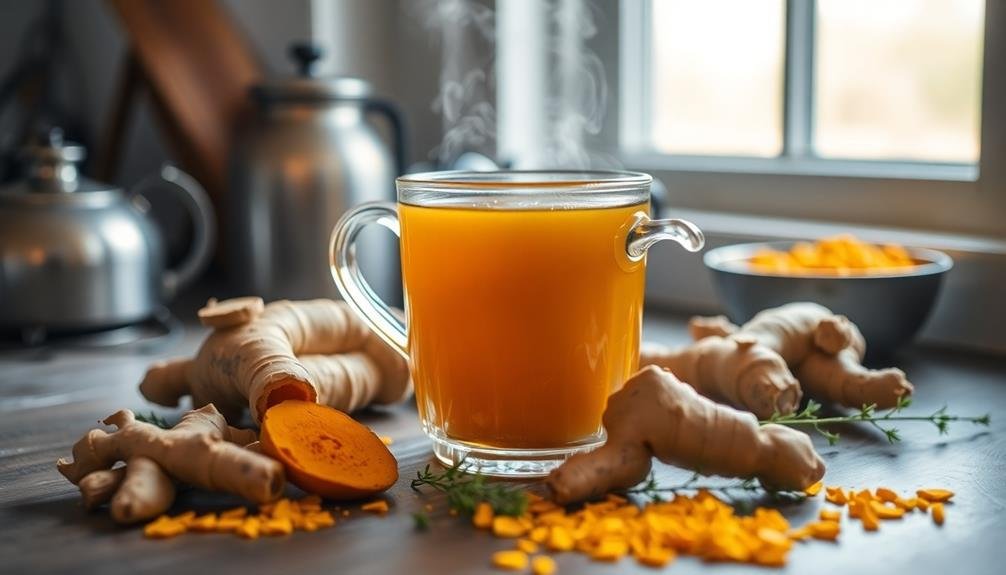
Ginger and turmeric come together in a soothing herbal tea blend that not only warms your body but also offers a host of health benefits. This delightful combination helps reduce inflammation and supports digestion, making it a perfect choice for stress relief.
To prepare this calming tea, you'll need fresh ginger, fresh turmeric, water, and honey (optional). Start by peeling and slicing about one inch of fresh ginger and one inch of fresh turmeric.
In a saucepan, bring four cups of water to a boil. Add the sliced ginger and turmeric to the boiling water, and let it simmer for about 10 to 15 minutes. The longer you simmer, the stronger the flavor will be.
Once the tea has reached your desired strength, strain out the ginger and turmeric pieces. If you'd like, you can sweeten your tea with a bit of honey for extra flavor.
Enjoy your warm cup of ginger and turmeric tea, and take a moment to breathe deeply as you sip. This calming blend not only comforts your senses but also rejuvenates your spirit, making it an ideal remedy for those stressful days.
Recipe: Rooibos and Vanilla
Rooibos tea is packed with antioxidants and offers numerous health benefits, making it a great choice for relaxation.
When paired with vanilla, known for its calming properties, this blend creates a soothing experience.
You'll find that this combination not only tastes delightful but also helps you unwind after a long day.
Health Benefits of Rooibos
When you sip on a cup of rooibos tea, you're not just enjoying a delicious beverage; you're also reaping numerous health benefits. This naturally caffeine-free tea, rich in antioxidants, can be a fantastic addition to your wellness routine.
Consider these remarkable advantages of rooibos:
- Rich in antioxidants: Helps combat oxidative stress and supports overall health.
- Supports digestive health: Soothes tummy troubles and promotes gut health.
- May improve heart health: Contains compounds that can help lower blood pressure and cholesterol levels.
- Boosts immune system: Offers protection against common colds and infections with its anti-inflammatory properties.
- Promotes healthy skin: Packed with alpha hydroxy acid and zinc, it may help reduce acne and promote a radiant complexion.
Incorporating rooibos into your daily routine can be a simple yet effective way to enhance your health.
By enjoying a warm cup of rooibos and vanilla tea, you're not only indulging your taste buds but also nurturing your body with every sip.
Embrace the calming effects and numerous benefits that this herbal gem has to offer!
Vanilla's Calming Properties
Incorporating soothing flavors into your tea can elevate your relaxation experience, and vanilla is a perfect choice. Known for its warm, comforting aroma, vanilla has calming properties that help reduce stress and anxiety.
When you sip on a cup of rooibos tea blended with vanilla, you're not just enjoying a delicious drink; you're also nurturing your emotional well-being.
Vanilla contains compounds that promote relaxation and improve mood. The scent of vanilla can trigger the release of dopamine, the "feel-good" hormone, making you feel more at ease. Plus, its natural sweetness can satisfy your cravings without added sugar, keeping your mind uncluttered.
To make a delightful Rooibos and Vanilla tea, steep a teaspoon of loose rooibos in hot water for about five minutes. Then, add a splash of pure vanilla extract or a piece of vanilla bean for an aromatic twist.
This blend not only tastes fantastic but also fosters a calming atmosphere, perfect for winding down after a long day.
Next time you need a break, treat yourself to this soothing tea, and let the calming qualities of vanilla wash over you, relaxing both your mind and body.
Recipe: Hibiscus and Cinnamon
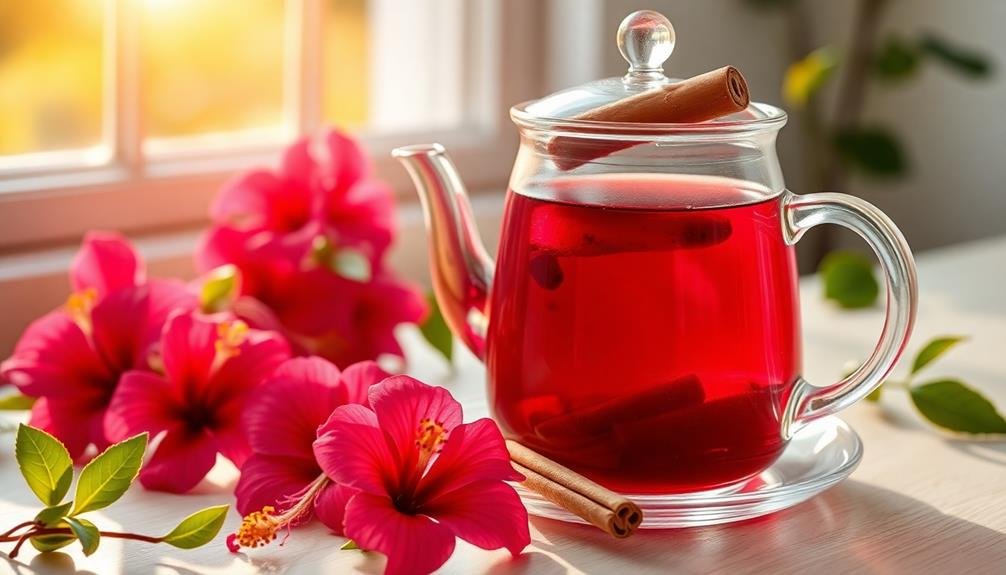
As the sun sets and a sense of calm envelops the evening, a cup of hibiscus and cinnamon tea can be the perfect way to unwind. This delightful blend not only tantalizes your taste buds but also offers a soothing experience that helps melt away the stresses of the day.
The tartness of hibiscus harmonizes beautifully with the warm sweetness of cinnamon, creating a comforting drink that warms your soul.
Here's what you'll need to create this calming brew:
- Dried hibiscus flowers, their deep red hue bringing vibrant color to your cup
- Cinnamon sticks, releasing their fragrant aroma as they steep
- Boiling water, the bubbling sound creating a cozy ambiance
- Honey or maple syrup, to add a touch of sweetness
- A slice of lemon, brightening the flavor and adding a revitalizing twist
To prepare, simply steep a tablespoon of hibiscus and a cinnamon stick in boiling water for about 10 minutes.
Sweeten to your liking, and enjoy the calming effects this tea offers. Sip slowly, savoring each moment as you let your worries drift away.
Recipe: Valerian Root Blend
If you're seeking a deeper level of relaxation, the valerian root blend might just be what you need. This herbal tea is renowned for its calming properties, making it a perfect choice to unwind after a long day.
To create your own valerian root blend, you'll need a few simple ingredients: 1 tablespoon of dried valerian root, 1 teaspoon of chamomile flowers, and 1 teaspoon of lemon balm.
Start by combining the valerian root, chamomile, and lemon balm in a bowl. This mix not only enhances the flavor but also boosts the calming effects.
When you're ready to brew, add 1 cup of boiling water to 1 tablespoon of your blend. Let it steep for about 10-15 minutes. You can adjust the steeping time based on your taste preference; longer steeping can intensify the flavors.
Once brewed, strain the tea into your favorite mug. You might want to add a touch of honey or lemon for sweetness, but it's delightful on its own.
Sip slowly and enjoy as you feel the stress melt away, allowing your body and mind to embrace tranquility.
Tips for Brewing Herbal Tea
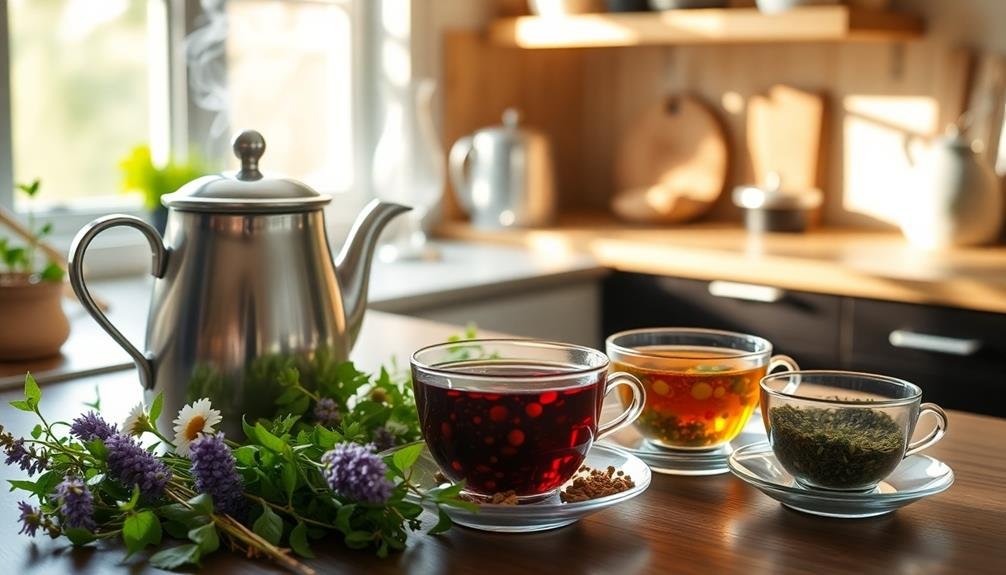
Brewing herbal tea can be a delightful experience, and a few simple tips can enhance your process. First, always use fresh, high-quality herbs. Dried herbs can lose potency, so look for vibrant colors and strong aromas.
Next, measure your herbs carefully—typically, one teaspoon per cup of water works well.
Temperature is essential; different herbs require specific water temperatures. For delicate flowers, like chamomile, use water just off boiling, while sturdier herbs, like ginger, benefit from boiling water.
Steep your tea for the right amount of time; too short, and you'll miss out on the flavors, too long, and it can become bitter.
Here are some helpful tips to keep in mind:
- Use filtered water for the best taste.
- Choose a cozy spot to brew and enjoy.
- Experiment with combining herbs for unique flavors.
- Cover your tea while steeping to lock in essential oils.
- Savor the aroma before taking your first sip.
Storing Your Herbal Blends
Properly storing your herbal blends is essential for preserving their flavor and potency.
First, choose an airtight container to keep out moisture and air. Glass jars with tight-fitting lids work great, but dark glass is even better, as it protects your herbs from light exposure. If you don't have dark glass, store your jars in a dark cupboard.
Next, keep your containers in a cool, dry place. Avoid areas near heat sources, like stoves or direct sunlight, which can degrade the herbs over time. Ideally, a pantry or a dedicated herb cabinet is perfect.
Label your containers with the blend name and the date you made it. That way, you'll know exactly how fresh your herbs are and when to use them.
Most blends stay potent for about six months to a year, depending on the herbs used.
Frequently Asked Questions
Can I Use Dried Herbs Instead of Fresh Ones?
Yes, you can use dried herbs instead of fresh ones. Just remember, dried herbs are more concentrated, so you'll need less. Adjust your measurements, and don't forget to experiment to find your preferred flavor balance!
How Often Should I Drink Herbal Tea for Stress Relief?
You should drink herbal tea for stress relief regularly, ideally once or twice a day. Consistency helps your body adapt and benefits your mental well-being. Just listen to your body and adjust as needed.
Are There Any Side Effects of Herbal Teas?
Herbal teas can cause side effects, like allergic reactions or digestive issues, especially if you're sensitive to certain herbs. It's wise to start with small amounts and monitor how your body reacts. Always consult a professional if unsure.
Can Children Drink Herbal Teas Safely?
Yes, children can drink herbal teas safely, but it's essential to choose age-appropriate options. Always consult a pediatrician first, as some herbs may cause allergies or interact with medications. Moderation is key for their safety.
Is It Safe to Combine Different Herbal Blends?
Combining different herbal blends can be safe, but you should always check each herb's potential interactions. It's best to consult with a healthcare professional to guarantee you're making a safe choice for your health.
In Summary
Incorporating calming herbal tea blends into your routine can be a delightful way to unwind and relieve stress. With a variety of soothing ingredients at your fingertips, you can easily create your own unique blends tailored to your taste. Remember to brew them with care and store them properly to preserve their benefits. So, take a moment for yourself, sip on a comforting cup, and let the natural power of herbs help you find your calm.

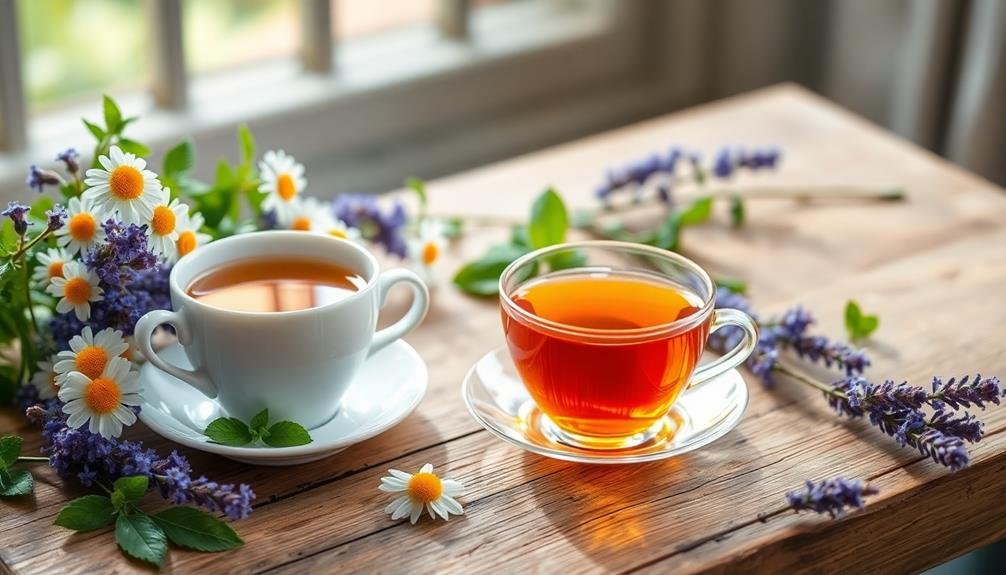
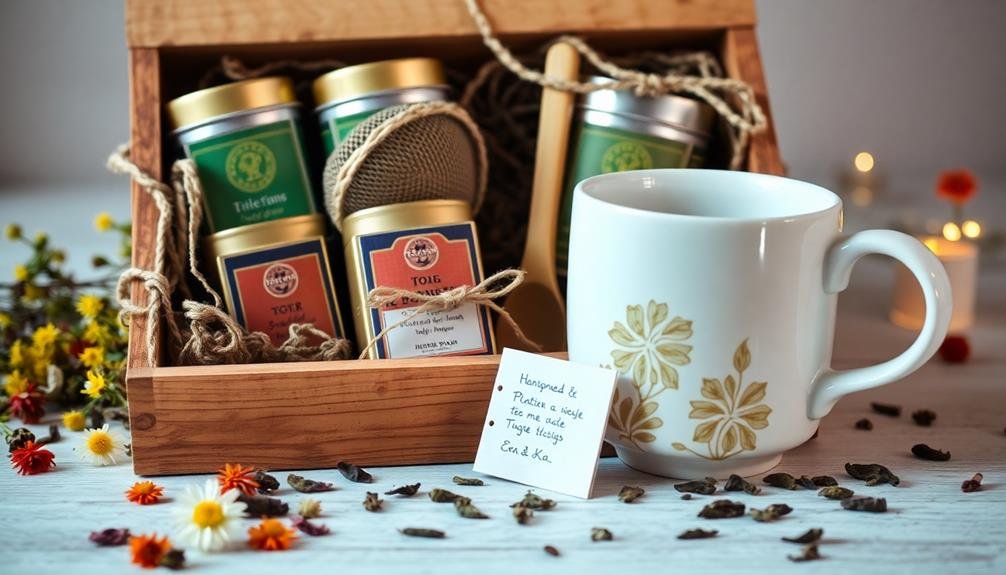
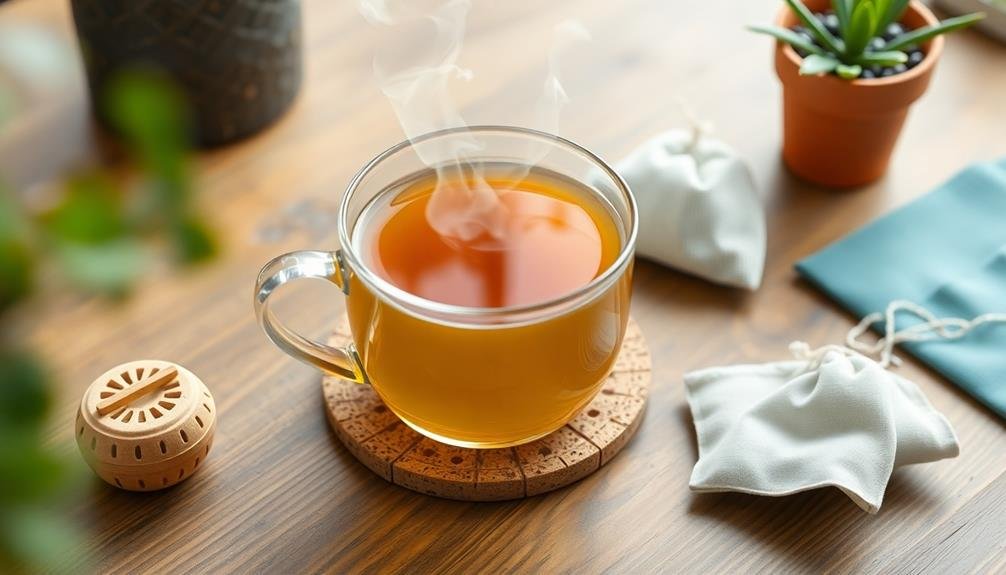
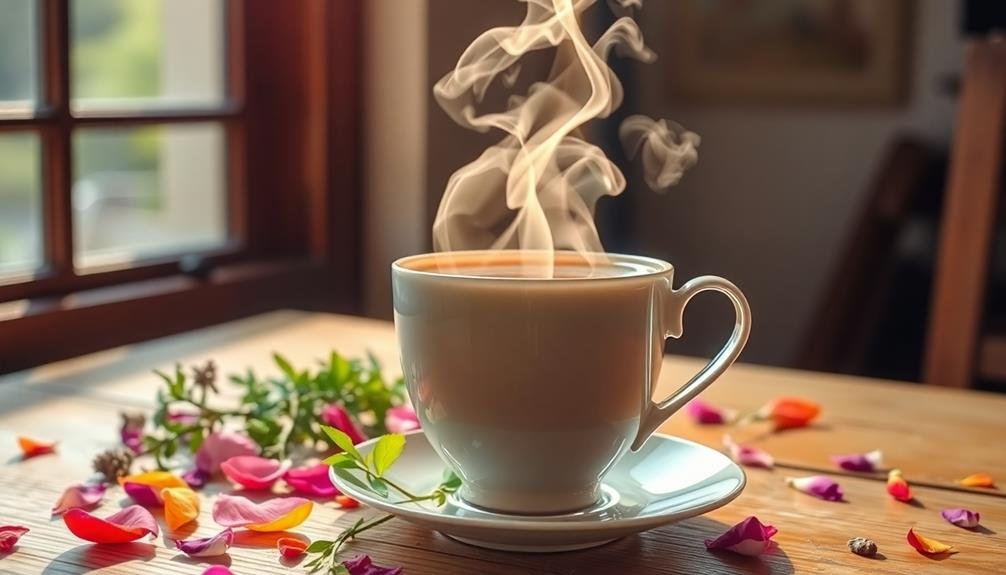
Leave a Reply